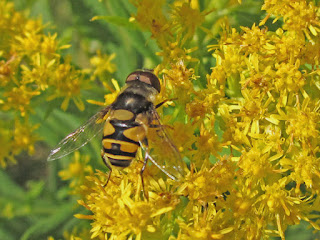 |
| Megacyllene robiniae - Locust Borer |
I've been looking at goldenrods lately - seeing insects I've never noticed before.
I have to admit I have a bias. I'm willing to spend time looking at - and looking up - a butterfly or moth. But for most of the other insects - I don't get much further than "wasp," "bee," or "beetle."
The name is the key to learning more about them.
My problem: I just don't think I have the skill (or patience) to "key" them out.
Today I decided to give it a try. I started with the insects I photographed on goldenrod earlier this week.
First, the beetle (the Locust Borer in the photo above). I pulled out a copy of the Peterson Field Guide (Beetles by White), leafed through it and found a black and white illustration (figure 123) that fit. Then I googled it. That success gave me the confidence to continue.
 |
| Heliothis zea - Corn Earworm Moth |
I was pretty confident the next one (above) is a moth. But after 15 minutes I wasn't so sure. I couldn't find it in the dizzying array of moths in the Peterson Field Guide. So I uploaded it to BugGuide.net. Ten minutes later, I got an email with the ID. Amazing!
It's a Corn Earworm moth, one of the nearly 3,000 North American species in the Noctuoidea superfamily. The adult moth feeds on nectar and is associated with goldenrods in the fall. Look for the green eye. (If you've ever opened an ear of corn and found a "worm" - chances are you've seen the larvae of this moth.)
Next was this wasp. Which species? I went to BugGuide again, and was surprised to discover it's one of the ~17 paper wasp species (Polistes) in North America. This one's a male Northern Paper Wasp (the long antennae, square yellow face and blunt tip to the abdomen).
The Northern Paper Wasp "nest" is created by a dominent "gyne" (reproductive female) who builds an open-chambered nest and, without help, feeds the first batch of larvae. When the first batch emerge, they stick around and help the dominent one raise the second brood. In late summer, males hatch out. They live a month or so and die when their job - fertilizing the recent hatch of females - is finished. Fertilized females hibernate and start new colonies in the spring.
In the fall, these wasps feed on nectar. In the summer, they feed on caterpillars and juices from ripe fruits.
Entomologists are concerned that the introduction of the more aggressive European Paper Wasp (in the 1970s) has had an adverse impact on native Polistes. Time will tell.
 |
| Eristalis transversa - Transverse Flower Fly |
On to the last picture, a yellow and black insect. I thought this one would be easy to identify. It looks like a bee. Buzzes like a bee. Must be a bee. Not!
I didn't find it in the Peterson Field Guide, so I up-linked this photo to BugGuide. Minutes later, I got the ID. It's a fly - a bee mimic known as the Transverse Flower Fly.
There are 23 species of flower flies in North America. Their larvae which are found in polluted water, are known as “rat-tailed maggots” a reference to the long breathing tube they extend to the surface of the water. The adults are nectar-feeders.
If you spot one, take a close look at its head - it has hair on its eyes!



> Hello! My name is Patrick Siwula and I am an environmental science major
ReplyDelete> studying at the University of Wisconsin La Crosse. The reason I am emailing
> you is to ask permission to use a photo from your website for an academic
> website that I am making as a requirement for one of my classes. The
> assignment is to make a website profiling a certain type of insect and my
> group's species is Eristalis transversa. I noticed you have a beautiful
> photograph of this specimen on your website and I would like to know if it
> would be alright with you if we used it for our project. The photo would be
> properly cited and you would receive credit for your work. Additionally,
> while the website will be open to the general public, it is a strictly
> academic website hosted on our schools academic web server and the photo
> will only be used for academic purposes. I appreciate your consideration in
> this matter and hope to hear back from you soon!
> thanks!
> -Patrick Siwula